|
a Field Microscope: Cryptobiotic Soil By Wayne Lanier, USA |
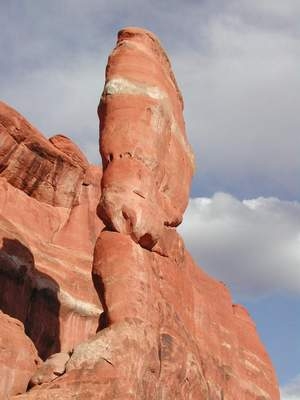 |
|
a Field Microscope: Cryptobiotic Soil By Wayne Lanier, USA |
 |
Walking a “Fin”, as I discovered, was not my favorite mode of travel. Most of the Fin was about five-foot wide, except for those parts that were four-foot wide. I kept to the lee side, where the drop down was only about twenty-five feet. To starboard it was a sheer drop of 300-feet. The wind was up and kept buffeting me to starboard.We were on a 6-mile hike along the Devil's Garden Trail at Arches National Park, Utah. I have no pictures of the Fin we hiked on. The lead picture shows a Fin that we saw on the Fiery Furnace Trail later that afternoon. It is a bit of an exaggeration, since the Fin we hiked on started and ended on solid footing, but I felt as unstable as the knob atop this one appears. Fins are created by erosion and, as you will see, erosion is an essential theme of this story.
This is my second article about Hiking with a Field Microscope. If you read my first one, you know I see field microscopy as part of a total picture. That still goes. What follows is a little geology, a little anthropology, a little natural history, and even more about Cryptobiotic Soils.
A few things have changed. I have improved my Swift FM 31 with the addition of a LazerBright LED light. This very bright LED just fits the Swift microscope and provides sufficient light for photomicrography for many weeks from two tiny CR209 batteries!
I have also started using a Nikon Coolpix 885 digital camera. The reference is to a review, since the Nikon web site requires downloading software to see the camera. I spent about 4-months choosing a digital camera. The choice of the Coolpix 885 represented the smallest camera providing at least 3-megapixels resolution, a small lens diameter, and sufficient optical zoom and digital zoom to avoid vignetting.
One can shoot photomicrographs by holding the camera to the microscope eyepiece. For convenience, I added a used Leitz Wetzlar #519-815 Periplan GF 10X/20 eyepiece. This wide field eyepiece has 28-mm threads that screw directly into the attachment ring, enabling the camera to be securely attached to the microscope. A variety of other devices are available to attach digital cameras to a microscope eyepiece. I have since tried a Canon 2.1-MP PowerShot S110 Digital Elph, a Kodak DC 3400 200M Digital camera [2.0-MP], and an Olympus C-3020 Camedia [3.3-MP]. The first two performed well, but the lens on the Olympus is much larger than the eyepiece lens and this results in vignetting. For those who would like more information about the LED lights, about using digital cameras, or about placing scale bars in digital photomicrographs, please contact me.
The Colorado Plateau is geologically and ecologically unique. It occupies a good part of the Four Corners area, where the four square corners of Utah, Colorado, New Mexico, and Arizona meet. It has been a single geological province for 500-million years, much of that time under shallow seas [REF 1]. Most of its strata are marine-deposited sandstone. The Triassic Navajo Sandstone, 2,500-ft thick, is one such sandstone. Another is the Entrada Sandstone. Still showing the “petrified dunes” of their shallow-sea history, water has eroded these formations from flat plateaus into Fins, Hoodos, Towers, Knobs, Arches, Bridges, and caves. Most of the excitement that produced the present-day exotic geology is water erosion that happened so recently as to be coincident with human evolution.
Our trip was a two-week spring visit to the US National Parks and Monuments in Utah. We hiked in Arches, Canyonlands, Natural Bridges, Cedar Mesa, Escalante Winding Staircase, Bryce Canyon, and Zion. We had driven from San Francisco and this bit of roadside art in Nevada showed how we felt coming back.
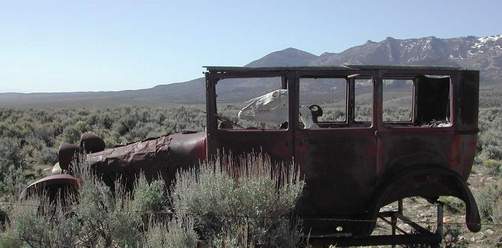
The spring flowers were out, those brilliant desert plants that bloom the instant it rains [REF 2]. Many of the animals were noticed by their leavings, which is why I carried my “Scats & Tracks” [REF 3]. We did see many lizards and one female wild turkey.
We found a number of abandoned cliff dwellings. Over a span of 8,000-years the “ancestors” [called “Anasazi” by the Navajo] built stone houses and lived on flat-floored niches in the cliff faces of canyons [REF 4]. Frequently they decorated vertical surfaces nearby with petroglyphs, which may have served as warnings, religious symbols, or simply “news”. Cliff dwellings and petroglyphs are found throughout the Colorado Plateau. Wind, cold and water also shaped the ancestors’ life-style, forcing them to abandon the cliff dwellings during the 12th century AD. In Utah, cliff dwellings are small and usually quite old, but in Chaco Canyon, New Mexico, the ancestors built a large central city with four-story stone buildings and some 400-miles of paved road. My photograph of Cliff Dwellings was taken in Cedar Mesa, and the photograph of petroglyphs was taken at “News Rock”, near Canyonlands.
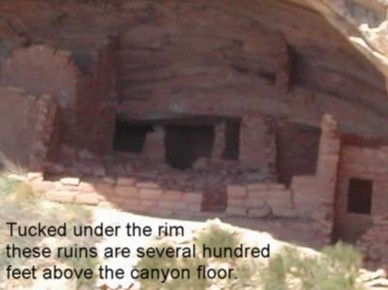
Cryptobiotic Soil crusts [REF 2] are now recognized as playing an important ecological role in the cold, dry deserts of the Colorado Plateau. Shown is a close-up of about a square-foot of mature Cryptobiotic Soil, mostly sand. The dark areas are typical of well-developed crust, and the lichens on the central clump of soil show maturity.
Although this soil community also contains lichen and mosses, it is initiated by and dominated by cyanobacteria. On the Colorado Plateau, the species of cyanobacteria commonly found in cryptobiotic soil is Microcoleus vaginatus.
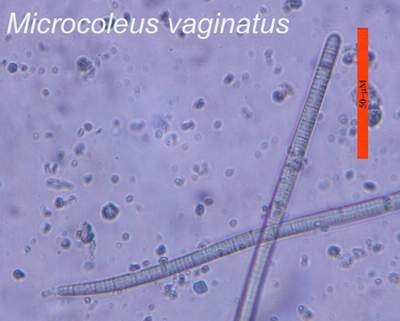
Scale bar 50 µm
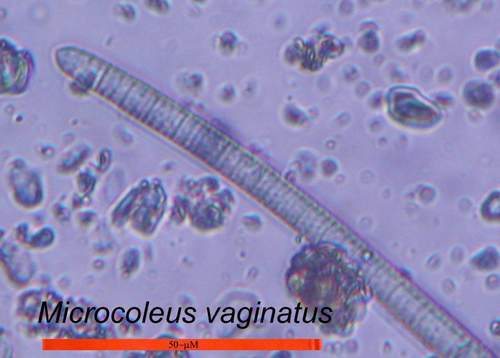
Scale bar 50 µmM. vaginatus is a large, filamentous green cyanobacterium. Each segment in a filament is an individual bacterium. Filaments range considerably in length. Shown below is a short filament, but I found some filaments as long as 300 µm.
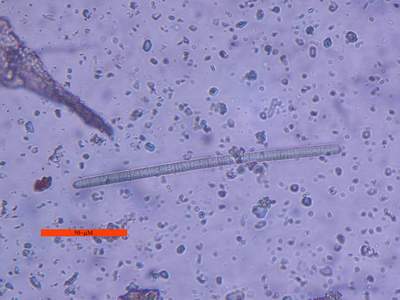
Scale bar 50 µmCyanobacteria are photosynthetic and were originally called “blue-green algae”. At one time they were studied in botany departments, but got kicked over to the microbiology departments when it was discovered they were actually bacteria. Many are motile, but M. virginatus is not.
One of the more interesting and increasingly accepted hypotheses of evolution is that chloroplasts, the photosynthetic organelles of higher plants, were originally cyanobacteria [REF 5]. According to this hypothesis, some early eucaryotic cell ingested a cyanobacterium and the two negotiated a mutualism that, in plant cells, has lasted to this day.
In dry soil, M. vaginatus remains dormant in a cryptobiotic [desiccated] state. When water is provided, the bacterial filaments come out of dormancy and, given sunlight, begin growing rapidly. I examined dry cryptobiotic sand and found no apparent cyanobacterial filaments. When water was added, filaments were evident within a matter of minutes.
Although the transition from a cryptobiotic state to an actively growing state is rapid, achieving a cryptobiotic state takes much longer and requires many physiological changes. The water content of soil is high, even as it dries out. During desiccation, it passes through a long phase during which the relative humidity of the atmosphere in the spaces between the grains is near 99%. This triggers the physiological changes that enable cryptobiotic organisms to survive desiccation and cold.
As they grow, the bacterial filaments produce a sticky mucilaginous polysaccharide sheath, usually covering a number of filaments.
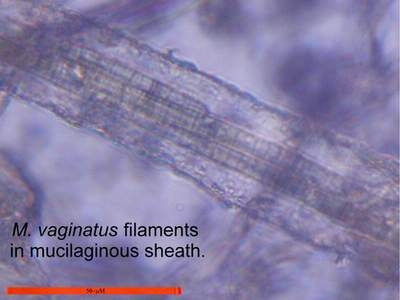
Scale bar 50 µmThis sticky mucilaginous sheath binds the filaments to soil particles, producing a matrix that is sufficiently strong to make the soil surface crusty. As the soil dries out, the filaments return to a cryptobiotic state, and the sheath around them remains connected to the soil grains, pulling the grains tightly together.
The binding quality of the cyanobacteria is evident from the observation that the angle of repose for dry cryptobiotic sand is much steeper than for ordinary dry sand, which is about 34°. You can get a sense of this by examining the larger fragments in the picture of cryptobiotic soil. The face of the dark mottled area to the right of the lichen-dotted fragment was almost perpendicular. At many places on the Colorado Plateau I saw large expanses of stable dry sand on slopes as steep as 45°. This crust resists wind erosion and, to a great extent, water erosion.
With time, fungi, algae, lichens, and mosses join the community and it becomes an inviting place for colonization by higher plants. Notice that the Claret Cup in the photograph near the beginning of this article is growing on cryptobiotic soil. Cryptobiotic soil is the first step in producing arable soils in a desert ecosystem, playing an essential role in stabilizing desert soil and limiting erosion. When dry, however, cryptobiotic soil is brittle and does not resist footprints. Wind and water erosion follows quickly, once a careless hiker breaks the crust. The shortest recovery time for such disturbed soil is in the order of 5 years. A mature soil may take up to 50 years to form.
Photomicrographs of Microcoleus vaginatus were made in the field at Arches National Park, Utah [N 38-deg 46.925' W109-deg 35.677'], on the Devils Garden Loop Trail near Landscape Arch. A hiker had left the trail and disturbed an area of cryptobiotic soil. Some of the cryptobiotic soil fragments had been kicked onto the trail from the disturbed area. I placed few grains of this soil onto a microscope slide and wet them with about 50-microliters of water. Then I put a cover slip over the soil/water mixture and placed the slide in a shady area for awhile before popping it under the microscope.
After observation and photographing, the contents of the slide were washed back onto the soil near the trail. The National Park rules require that “nothing be taken out” and that you leave intact cryptobiotic soil crust undisturbed. If you want to observe the life in cryptobiotic soil, sample from the trail where hikers are already walking. If you want to keep a sample for extended observation, collect it outside the National Park areas [almost all sandy soil anywhere in the Colorado Plateau develops cryptobiotic crust].
My observations were made over a period of about 30-minutes, at 40X, 100X, 400X, and 800X under both brightfield and phase contrast. Photomicrographs were taken at 400X bright field using my Nikon Coolpix 885 digital camera, with full optical zoom and either no “electronic zoom” or 2.0X electronic zoom. About half the full optical zoom was necessary to prevent vignetting, but intermediate values of optical zoom are not calibrated and I found it simpler to always use the full value.
In conclusion, one could easily spend a lifetime of vacations hiking the various parts of the Colorado Plateau and observing the many ways life has adapted to its harsh conditions. Everywhere, life struggles against the erosion that promises to wear the high plateau down to a low plain.
Besides cryptobiotic soil, in our brief trip I encountered new micro-flora in ephemeral pools, dry streambeds, vertical communities next to waterfalls, and seep communities.
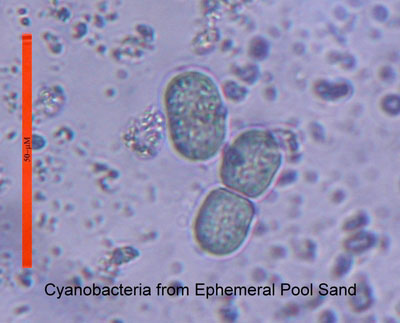
Scale bar 50 µmPerhaps the most fascinating of these other communities were ephemeral pools: Shallow sandy-bottomed depressions in the rim rock above the canyons. I tried to photograph the Whiptail lizard shown earlier as it paused in such a depression, but it hurried on to bare rock. A microscopic examination of the dry sand from one of these depressions shows only a few diatom skeletons. Such depressions fill with water after a rain, and from the sand explodes a community of microbes: Cyanobacteria of many kinds, diatoms, algae, fungi, lichens, protozoa, rotifers, nematodes, and higher creatures that have found ways of surviving periods of intense cold, heat, and desiccation. Some produce resistant spores or other propagules, some enter directly into cryptobiotic states, but all are equipped to rapidly return to active metabolism when the rains come and all complete a life cycle with the metronome ticking at “presto”. In the photomicrograph above, green cyanobacteria were apparent within minutes of adding 100-microliters of water to a little dry sand in a depression slide. In less than an hour, these motile cells were dividing and moving at their slow and stately pace!
All comments to the author, Wayne Lanier, are welcomed.
REFERENCES
[1] Fran A. Barnes (2000) Canyon Country Geology for the Layman and Rockhound: A guide to understanding the unique and spectacular geology of the canyon country of southeastern Utah and vicinity, with a special section on rockhounding. Arch Hunter Books, Thompson Springs, UT. 160-pp. $12.95.
[2] David Williams and Gloria Brown (2000) A Naturalist’s Guide to Canyon Country. Falconâ Publishing, Inc., Helena, MT, in cooperation with Canyonlands Natural History Association. 188-pp. $22.95. Note Gloria Brown’s excellent illustrations.
[3] James C. Halfpenny and Todd Telander (2000) Scats and Tracks of the Desert Southwest - A Field Guide to the Signs of 70 Wildlife Species. Falconâ Publishing, Inc., Helena, MT. 144-pp. $9.95.
[4] Val Brinkerhoff and A. Dudley Gardner (2000) Architecture of the Ancient Ones. Gibbs Smith, Layton, Utah. 80-pp. $19.95.
[5] Lynn Margulis and Dorion Sagon (1986) Microcosmos - Four Billion Years of Evolution from Our Microbial Ancestors. Simon & Schuster Touchstone Books, NY. 298-pp. $10.00. See Chapters 6 and 7.
How to contact me. I live in San Francisco. If you are planning a visit and have time for a field trip, let me know. I am always happy to take visitors out to the local tide pools, salt marshes, hot springs, or wetlands.
Please report any Web problems
or offer general comments to the
Micscape
Editor,
via the contact on current
Micscape Index.
Micscape is the on-line monthly
magazine of the Microscopy UK web
site at Microscopy-UK